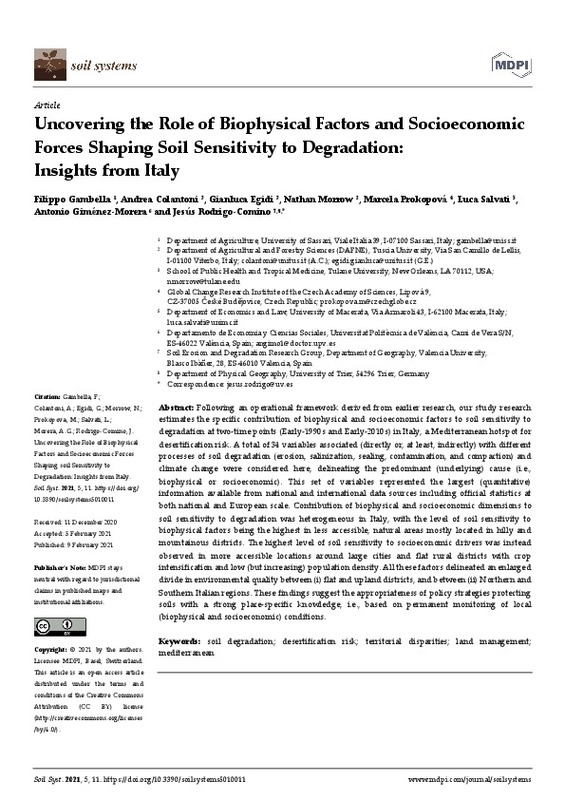JavaScript is disabled for your browser. Some features of this site may not work without it.
Buscar en RiuNet
Listar
Mi cuenta
Estadísticas
Ayuda RiuNet
Admin. UPV
Uncovering the Role of Biophysical Factors and Socioeconomic Forces Shaping Soil Sensitivity to Degradation: Insights from Italy
Mostrar el registro sencillo del ítem
Ficheros en el ítem
| dc.contributor.author | Gambella, Filippo
|
es_ES |
| dc.contributor.author | Colantoni, Andrea
|
es_ES |
| dc.contributor.author | Egidi, Gianluca
|
es_ES |
| dc.contributor.author | Morrow, Nathan
|
es_ES |
| dc.contributor.author | Prokopova, Marcela
|
es_ES |
| dc.contributor.author | Salvati, Luca
|
es_ES |
| dc.contributor.author | Giménez Morera, Antonio
|
es_ES |
| dc.contributor.author | Rodrigo-Comino, Jesús
|
es_ES |
| dc.date.accessioned | 2022-03-23T19:03:33Z | |
| dc.date.available | 2022-03-23T19:03:33Z | |
| dc.date.issued | 2021-03 | es_ES |
| dc.identifier.uri | http://hdl.handle.net/10251/181521 | |
| dc.description.abstract | [EN] Following an operational framework derived from earlier research, our study research estimates the specific contribution of biophysical and socioeconomic factors to soil sensitivity to degradation at two-time points (Early-1990s and Early-2010s) in Italy, a Mediterranean hotspot for desertification risk. A total of 34 variables associated (directly or, at least, indirectly) with different processes of soil degradation (erosion, salinization, sealing, contamination, and compaction) and climate change were considered here, delineating the predominant (underlying) cause (i.e., biophysical or socioeconomic). This set of variables represented the largest (quantitative) information available from national and international data sources including official statistics at both national and European scale. Contribution of biophysical and socioeconomic dimensions to soil sensitivity to degradation was heterogeneous in Italy, with the level of soil sensitivity to biophysical factors being the highest in less accessible, natural areas mostly located in hilly and mountainous districts. The highest level of soil sensitivity to socioeconomic drivers was instead observed in more accessible locations around large cities and flat rural districts with crop intensification and low (but increasing) population density. All these factors delineated an enlarged divide in environmental quality between (i) flat and upland districts, and between (ii) Northern and Southern Italian regions. These findings suggest the appropriateness of policy strategies protecting soils with a strong place-specific knowledge, i.e., based on permanent monitoring of local (biophysical and socioeconomic) conditions. | es_ES |
| dc.language | Inglés | es_ES |
| dc.publisher | MDPI AG | es_ES |
| dc.relation.ispartof | Soil Systems | es_ES |
| dc.rights | Reconocimiento (by) | es_ES |
| dc.subject | Soil degradation | es_ES |
| dc.subject | Desertification risk | es_ES |
| dc.subject | Territorial disparities | es_ES |
| dc.subject | Land management | es_ES |
| dc.subject | Mediterranean | es_ES |
| dc.title | Uncovering the Role of Biophysical Factors and Socioeconomic Forces Shaping Soil Sensitivity to Degradation: Insights from Italy | es_ES |
| dc.type | Artículo | es_ES |
| dc.identifier.doi | 10.3390/soilsystems5010011 | es_ES |
| dc.rights.accessRights | Abierto | es_ES |
| dc.description.bibliographicCitation | Gambella, F.; Colantoni, A.; Egidi, G.; Morrow, N.; Prokopova, M.; Salvati, L.; Giménez Morera, A.... (2021). Uncovering the Role of Biophysical Factors and Socioeconomic Forces Shaping Soil Sensitivity to Degradation: Insights from Italy. Soil Systems. 5(1):1-15. https://doi.org/10.3390/soilsystems5010011 | es_ES |
| dc.description.accrualMethod | S | es_ES |
| dc.relation.publisherversion | https://doi.org/10.3390/soilsystems5010011 | es_ES |
| dc.description.upvformatpinicio | 1 | es_ES |
| dc.description.upvformatpfin | 15 | es_ES |
| dc.type.version | info:eu-repo/semantics/publishedVersion | es_ES |
| dc.description.volume | 5 | es_ES |
| dc.description.issue | 1 | es_ES |
| dc.identifier.eissn | 2571-8789 | es_ES |
| dc.relation.pasarela | S\428972 | es_ES |








